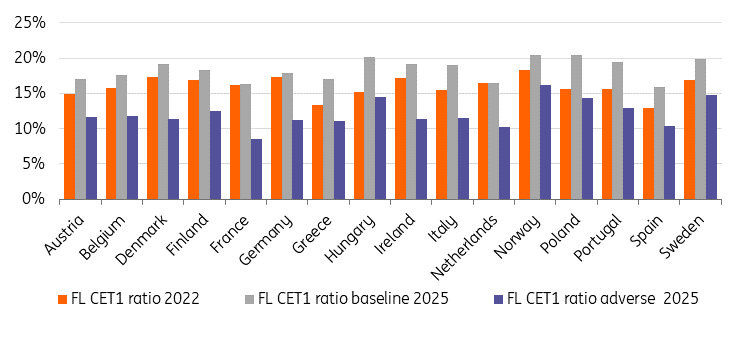Monday, July 31, 2023 9:04 AM EST
The European bank stress tests didn't reveal big capital gaps. Overall, we think the results confirm that the banking system is strongly capitalised and we see the results as supportive for bank risk.

Freepik
No "official" pass or fail in the stress tests, but some banks come out with very limited capital gaps
The European Banking Authority published the results of the European bank stress tests on Friday evening. The majority of banks weathered the adverse conditions well with only three banks falling short of the risk-weighted assets-based minimum capital requirements in the adverse scenario. Another four banks would fall short of the minimum leverage ratio-based requirements.
No big capital gaps were revealed, however. We would argue that German and French banks scored perhaps slightly weaker in the tests.
As the EBA puts it, the exercise is not meant to be a pass or fail exercise, but it acts as a supervisory tool and as an input for Pillar 2 assessments of banks. The EBA does not publish the names of individual banks that do not meet requirements.
We identify those banks falling short of the minimum requirements to be based in France, Germany, Greece and Italy. Most gaps in the requirements are, however, very limited. The only larger gap would be diminished by the application of the IFRS 17 standard.
Some banks would struggle to fill their buffer requirements despite staying above their minimum requirements
The tests, however, act as a good reminder that if the going gets tough, banks may face limitations on their distributions such as in paying their AT1 coupons. In the adverse scenario, several banks wouldn’t be able to fill their buffer requirements despite staying above their minimum capital requirements.
The EBA tests examined the resilience of 70 larger European banks in a baseline and adverse scenario in 2023-2025. The European Central Bank examined additional banks, with the total coming in at 98. The content published by the EBA can be found here and the ECB here.

ING, EBA
More By This Author:
Eurozone Returns To Positive Growth But Underlying Weakness Remains Asia Morning Bites - China PMI DataAsia Week Ahead: Reserve Bank Of Australia Policy Move And Regional PMI Data
Disclaimer: This publication has been prepared by the Economic and Financial Analysis Division of ING Bank N.V. (“ING”) solely for information purposes without regard to any ...
more
Disclaimer: This publication has been prepared by the Economic and Financial Analysis Division of ING Bank N.V. (“ING”) solely for information purposes without regard to any particular user's investment objectives, financial situation, or means. ING forms part of ING Group (being for this purpose ING Group NV and its subsidiary and affiliated companies). The information in the publication is not an investment recommendation and it is not investment, legal or tax advice or an offer or solicitation to purchase or sell any financial instrument. Reasonable care has been taken to ensure that this publication is not untrue or misleading when published, but ING does not represent that it is accurate or complete. ING does not accept any liability for any direct, indirect or consequential loss arising from any use of this publication. Unless otherwise stated, any views, forecasts, or estimates are solely those of the author(s), as of the date of the publication and are subject to change without notice.
The distribution of this publication may be restricted by law or regulation in different jurisdictions and persons into whose possession this publication comes should inform themselves about, and observe, such restrictions.
Copyright and database rights protection exists in this report and it may not be reproduced, distributed or published by any person for any purpose without the prior express consent of ING. All rights are reserved. ING Bank N.V. is authorised by the Dutch Central Bank and supervised by the European Central Bank (ECB), the Dutch Central Bank (DNB) and the Dutch Authority for the Financial Markets (AFM). ING Bank N.V. is incorporated in the Netherlands (Trade Register no. 33031431 Amsterdam). In the United Kingdom this information is approved and/or communicated by ING Bank N.V., London Branch. ING Bank N.V., London Branch is deemed authorised by the Prudential Regulation Authority and is subject to regulation by the Financial Conduct Authority and limited regulation by the Prudential Regulation Authority. The nature and extent of consumer protections may differ from those for firms based in the UK. Details of the Temporary Permissions Regime, which allows EEA-based firms to operate in the UK for a limited period while seeking full authorisation, are available on the Financial Conduct Authority’s website.. ING Bank N.V., London branch is registered in England (Registration number BR000341) at 8-10 Moorgate, London EC2 6DA. For US Investors: Any person wishing to discuss this report or effect transactions in any security discussed herein should contact ING Financial Markets LLC, which is a member of the NYSE, FINRA and SIPC and part of ING, and which has accepted responsibility for the distribution of this report in the United States under applicable requirements.
less
How did you like this article? Let us know so we can better customize your reading experience.





